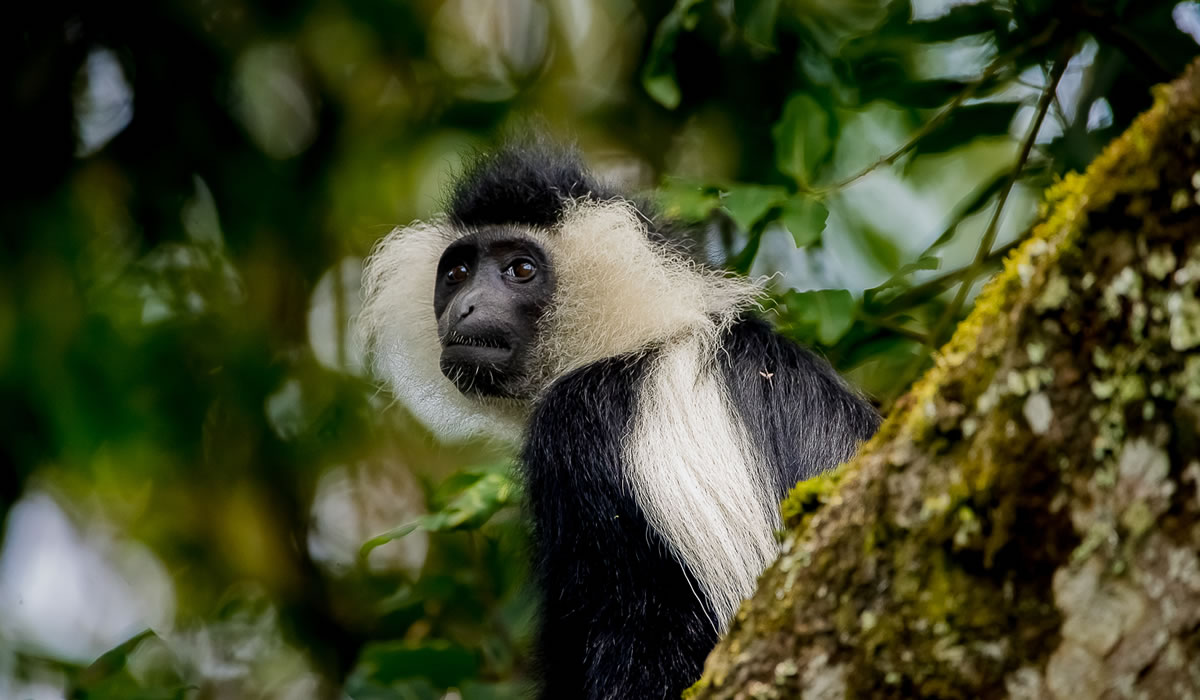Nyungwe Forest National Park offers one of Africa’s most remarkable primate experiences through colobus monkey tracking, providing visitors with extraordinary encounters with some of the continent’s most spectacular and acrobatic primates. Home to the largest troops of Angolan colobus monkeys in East Africa, Nyungwe Forest presents an unparalleled opportunity to observe these magnificent black and white primates in their natural montane rainforest habitat. Colobus monkey tracking in Nyungwe has become increasingly popular among wildlife enthusiasts seeking authentic primate encounters beyond the more commonly known gorilla and chimpanzee experiences.

The Colobus Monkeys of Nyungwe Forest
Nyungwe Forest harbors two distinct colobus species that create some of the most spectacular wildlife viewing opportunities in Rwanda. The Angolan colobus, also known as the Rwenzori colobus, represents the park’s most famous primate species after chimpanzees. These striking black and white monkeys form some of the largest troops ever recorded, with groups sometimes exceeding 300 individuals. The sight of these massive troops moving through the forest canopy, their long white tails flowing like silk banners, creates one of Africa’s most breathtaking wildlife spectacles.
The forest also hosts the black-and-white colobus (Colobus guereza), smaller in troop size but equally fascinating in behavior and appearance. Both species have evolved remarkable adaptations for their arboreal lifestyle, including specialized digestive systems that allow them to process the mature leaves that form the bulk of their diet. Their distinctive black fur with flowing white mantles makes them among the most photogenic primates in Africa.
These leaf-eating specialists play crucial ecological roles as seed dispersers and forest gardeners, helping maintain the complex forest ecosystem that has evolved over millennia. Their presence indicates healthy forest conditions, making them important indicator species for conservation efforts. The colobus populations in Nyungwe have remained stable thanks to the forest’s protected status and minimal human interference in their core habitats.
The Colobus Tracking Experience
Colobus monkey tracking in Nyungwe begins with early morning briefings at the park headquarters, where experienced guides share insights about colobus behavior, forest ecology, and tracking techniques. Unlike chimpanzee tracking, colobus encounters often prove more predictable due to their larger troop sizes and tendency to remain in specific forest areas for extended periods. The tracking experience typically involves moderate hiking through well-maintained forest trails, making it accessible to visitors with varying fitness levels.
The moment of encountering a large colobus troop ranks among Africa’s most awe-inspiring wildlife experiences. The forest canopy suddenly comes alive with movement as hundreds of black and white forms leap gracefully between branches, their acrobatic abilities defying belief. Adult males, distinguished by their impressive size and flowing white mantles, often position themselves as sentries while females with young create the troop’s social core. The cacophony of calls, from deep roars to gentle grunts, creates a symphony that echoes through the ancient forest.
Visitors typically spend one to two hours observing colobus troops, depending on the animals’ behavior and movement patterns. During feeding times, troops often remain relatively stationary, providing excellent photography opportunities and allowing for detailed behavioral observations. The monkeys’ natural curiosity sometimes brings them remarkably close to observers, creating intimate encounters that highlight their intelligence and complex social structures.
The tracking experience varies significantly based on weather conditions, season, and troop dynamics. Morning sessions generally offer the highest success rates, as colobus monkeys are most active during cooler hours when they engage in feeding, grooming, and social activities. The interplay of light filtering through the canopy during morning hours also creates optimal conditions for photography and wildlife observation.
Seasonal Patterns and Optimal Timing
Understanding seasonal patterns significantly enhances colobus tracking success and overall experience quality. The dry seasons, from June to September and December to February, provide the most comfortable tracking conditions with less muddy trails and clearer forest paths. During these periods, colobus troops often concentrate around reliable water sources and favored feeding trees, making encounters more predictable.
The rainy seasons, from March to May and October to November, offer unique advantages for colobus observation despite more challenging hiking conditions. The forest’s increased food abundance during rainy periods often results in larger, more active troops with enhanced breeding behaviors and social interactions. Young colobus are frequently born during these periods, providing opportunities to observe maternal behaviors and family dynamics within the troops.
Temperature and weather significantly influence colobus behavior patterns. Cool, overcast conditions often increase activity levels, while hot, sunny periods may cause troops to rest in shaded canopy areas. Morning tracking sessions, starting between 7:00 and 8:00 AM, consistently offer the best viewing opportunities as troops engage in their most active behaviors before the day’s heat intensifies.
Fruit availability throughout the forest creates seasonal variations in colobus distribution and behavior. While these primates primarily consume leaves, they supplement their diet with fruits, flowers, and bark when available. Understanding these seasonal food patterns helps guides predict troop movements and optimize tracking success rates.
Behavior and Social Structure Observations
Colobus monkey tracking provides fascinating insights into complex primate social structures and behaviors rarely observed in other wildlife experiences. Large Angolan colobus troops display intricate hierarchies with multiple adult males, numerous females, and offspring of various ages creating dynamic social networks. Observing grooming sessions, play behaviors among juveniles, and protective responses to perceived threats offers valuable educational opportunities about primate intelligence and social evolution.
The spectacular leaping abilities of colobus monkeys create continuous entertainment and amazement for observers. These primates can leap distances exceeding 15 meters between trees, using their long tails as balancing mechanisms and their powerful hind limbs for propulsion. Watching a large troop move through the canopy resembles a carefully choreographed aerial ballet performed by hundreds of acrobatic dancers.
Feeding behaviors provide particularly interesting observations as colobus monkeys demonstrate sophisticated food selection techniques. Despite their reputation as leaf-eaters, these primates show remarkable selectivity, choosing young leaves, shoots, and specific plant parts while avoiding mature or toxic vegetation. Their multi-chambered stomachs allow them to extract nutrients from fibrous plant materials that other primates cannot digest.
Communication within colobus troops involves complex vocalizations, body language, and scent marking that visitors can observe and learn to interpret. Deep roaring calls serve as territorial markers and troop coordination signals, while subtle facial expressions and gestures facilitate individual interactions within the social hierarchy.
Photography and Wildlife Viewing Tips
Successful colobus photography requires specific techniques adapted to forest canopy conditions and rapid monkey movements. Fast shutter speeds prove essential for capturing sharp images of moving primates, while longer focal length lenses allow for detailed shots without disturbing the animals. The contrast between black and white colobus fur can challenge camera exposure systems, making manual exposure control valuable for optimal results.
Early morning light provides the best illumination for colobus photography, with softer lighting that penetrates the forest canopy more effectively than harsh midday sun. Positioning yourself below active troops often yields dramatic silhouette shots against the canopy, while side-lighting can beautifully highlight the flowing white fur details that make these monkeys so photogenic.
Binoculars significantly enhance the colobus tracking experience, allowing detailed observation of facial expressions, grooming behaviors, and social interactions that might be missed with naked-eye viewing. Quality binoculars also enable observation of distant troops and help identify individual animals within large groups.
Patience proves crucial for optimal colobus viewing experiences. Unlike more predictable wildlife encounters, colobus troops may remain active for extended periods or suddenly become quiet and restful. Allowing sufficient time and maintaining quiet observation positions often rewards visitors with extraordinary behavioral displays and intimate wildlife moments.
Conservation Significance and Community Impact
Colobus monkey tracking generates crucial revenue for Nyungwe Forest conservation while creating economic incentives for local communities to support forest protection. The tourism income directly funds anti-poaching activities, habitat restoration projects, and scientific research that benefits not only colobus populations but the entire forest ecosystem.
Local communities surrounding Nyungwe benefit from colobus tracking through employment opportunities as guides, trackers, and porters. Many former hunters have transitioned into wildlife protection roles, becoming some of the most knowledgeable and dedicated guardians of the forest’s primate populations. This transformation demonstrates the power of eco-tourism to create sustainable conservation solutions.
The educational value of colobus encounters extends far beyond individual visitor experiences. Each tracking session provides opportunities to learn about forest ecology, conservation challenges, and the interconnected relationships that maintain healthy ecosystems. Visitors often become conservation advocates, supporting forest protection efforts long after their Nyungwe experience concludes.
Scientific research supported by colobus tracking tourism continues to expand our understanding of these remarkable primates and their forest habitat. Long-term studies of colobus behavior, population dynamics, and ecological relationships provide valuable data for conservation strategies throughout Africa.
Colobus monkey tracking in Nyungwe Forest offers an extraordinary wildlife experience that combines adventure, education, and conservation impact. These magnificent primates, with their spectacular acrobatic abilities and complex social structures, provide unforgettable encounters that highlight the incredible biodiversity of Rwanda’s montane forests. Whether you’re a seasoned wildlife enthusiast or discovering African primates for the first time, the colobus monkeys of Nyungwe promise to deliver one of Africa’s most remarkable and accessible primate experiences while supporting vital conservation efforts that ensure these ancient forests remain protected for future generations.

